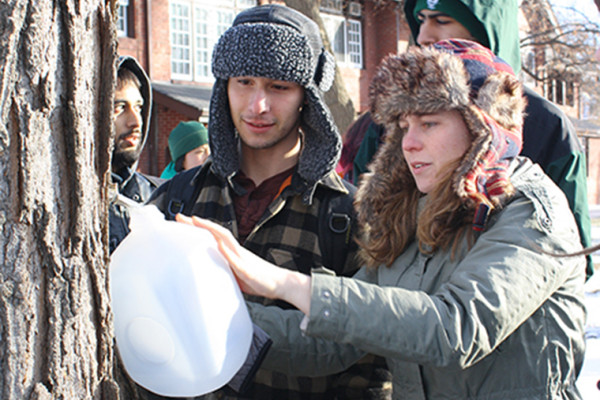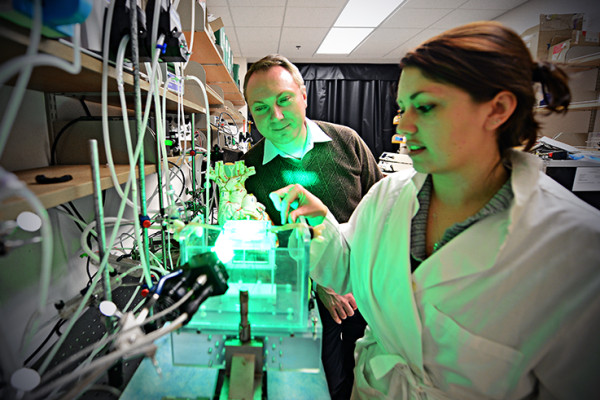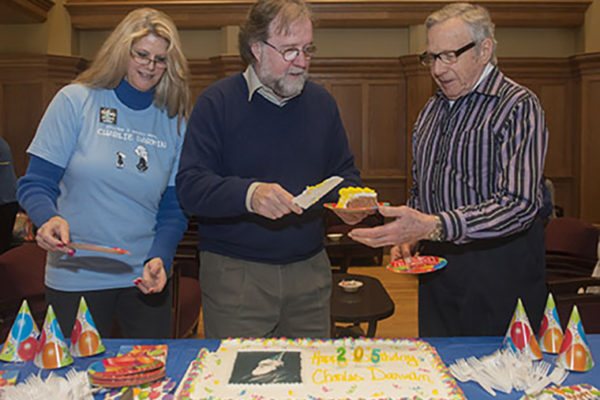Maple trees on campus tapped for class — and brunch
Washington University in St. Louis students joined Bon Appétit staff in preparing maple syrup and other locally collected foods for brunch this month at Ibby’s Bistro, all for their class with biology senior lecturer Stan Braude, PhD. The students tapped Danforth Campus maple trees and collected berries on the South 40 and acorns in nearby Forest Park.
3-D printer creates transformative device for heart treatment
Using an inexpensive 3-D printer, biomedical engineers, including Igor Efimov, PhD (left), the Lucy & Stanley Lopata Distinguished Professor of Biomedical Engineering have developed a custom-fitted, implantable device with embedded sensors that could transform treatment and prediction of cardiac disorders.
Frey wins teaching award
Regina (Gina) F. Frey, PhD, the Florence Moog Professor of STEM Education, has been honored with with an Excellence in Teaching Award from Emerson Electric Co.
CANCELED: Nobel laureate neuroscientist Eric Kandel explores art and the mind/brain for the Assembly Series
What happens in your brain when you look at this Klimt painting? A lot more than you might ever guess, according to Nobel laureate neuroscientist Eric Kandel, who will explore the connection between art and the mind/brain in his talk, “The Age of Insight: The Quest to Understand the Unconscious in Art, Mind and Brain from Vienna 1900 to the Present” for the Assembly Series at 5 p.m. Monday, March 3, in Graham Chapel.
Patti wins Sloan Research Fellowship
The Alfred P. Sloan Foundation announced Feb. 17 that
Washington University in St. Louis’ Gary Patti has been awarded a 2014 Sloan Research Fellowship.
He is among 126 outstanding U.S. and Canadian researchers selected as
fellowship recipients this year. Awarded annually since 1955, the
fellowships are given to early-career scientists and scholars whose
achievements and potential identify them as rising stars, the next
generation of scientific leaders.
‘Evo devo’ expert returns to campus
Sean B. Carroll, PhD (left), vice president for science education at Howard Hughes Medical Institute, a WUSTL alum (AB ’79) and one of the country’s foremost experts on evolutionary developmental biology, returned to campus to help the Institute for School Partnership celebrate its annual Darwin Day event for area high school teachers. Instrumental in Carroll’s appearance was mentor and teacher David Kirk, PhD (right), professor emeritus of biology in Arts & Sciences, who called Carroll one of the most “distinguished graduates in biology the department has had.”
Students win international University Physics Competition
A WUSTL team learned last month that they had won the Gold Medal for their analysis of a problem during the international University Physics Competition, held in November. Using the principles of physics, they predicted characteristics of an animal on an extraterrestrial planet.
Students in CELect course make impact on local startups
St. Louis is becoming widely recognized as a successful hub for startup businesses, with a wide range of groups and services that provide a support network for budding entrepreneurs. WUSTL students are getting a firsthand look at one of those resources this semester as they help formulate pricing strategies, marketing plans and competitive analysis for businesses working at T-REX in
downtown St. Louis.
Putting the squeeze on rocks
WUSTL geologist Philip Skemer has built a custom-made rock-formation appartus that traps a rock sample between tungsten carbide anvils about a
quarter inch in diameter within a 100-ton hydraulic press and then twists the sample slowly from below. His target pressure is six giga-pascals, the pressure 250 kilometers down, to
the base of the tectonic plates. He will use the apparatus to determine through experiment the mechanisms that lead mantle rocks to flow, dragging the tectonic plates with them.
Skemer will use NSF CAREER award to understand rock flow in Earth’s mantle
Philip Skemer, PhD, assistant professor in the department of earth and planetary science in Arts & Sciences at Washington University in St. Louis, has won a prestigious Faculty Early Career Development Award (CAREER award) from the National Science Foundation. He will use the award for a series of experiments in which rock samples will be deformed at the extreme temperatures and pressures they encounter along the boundaries where plates collide.
Older Stories



